The curators of the Kent Museum invited me to yarn bomb the lamppost that stands outside the historic tavern. So I knit electric yellow lace panels to cover the glass faces of the lantern. I installed the artwork Energy in September 2020. My intention was to use this art installation to shed light on how we produce electricity.
Art, not yarn bombing
It’s not really yarn bombing because I was given permission to cover the structure. True yarn bombing has a guerilla character, like graffiti. But the idea of transforming an unremarkable architectural feature with knitting is consistent with the yarn bombing spirit of brightening the built landscape with splashes of color.
Olek, a well-known New York artist who has wrapped people, bicycles and swimming pools in brightly colored crochet bristles at the term. She was quoted in the New York Times saying: “I don’t yarn bomb, I make art.” I feel the same way.
Art prods you to see things differently
As I see it, art has goals beyond the act of making. One purpose is to prod viewers to see things differently, to notice things in the world they have taken for granted. After viewing my installation, one person who lives in the town where the Kent Museum is located asked me if the lamppost had always been there. “Yep, it has; you just never noticed it,” I replied. Covering part of a building with knitting pushes things into new prominence.
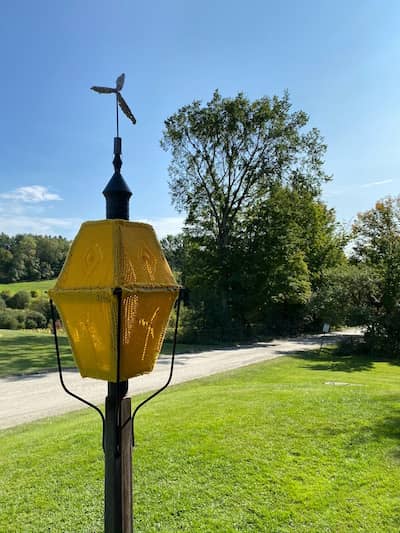
Energy, yarn, wire, wood, installation on lamppost at Kent Museum, Calais, VT © Eve Jacobs-Carnahan 2020.
Sunlight and lamplight become more visible too. When the sun is at just the right angle in the morning, the lamp captures the image of the flame from the top panel and projects it on to the diagonally facing panel. At dusk, when the lantern is turned on, the darkness softens the yellow yarn, turning it golden, and the glow of the lamp pours into the night.
Putting knitting on an inanimate object in the public sphere pushes you to see the knitting differently too. It becomes an artistic medium, not just a way of making clothing. Pulled in by curiosity, viewers see the complexity of the stretched lace.
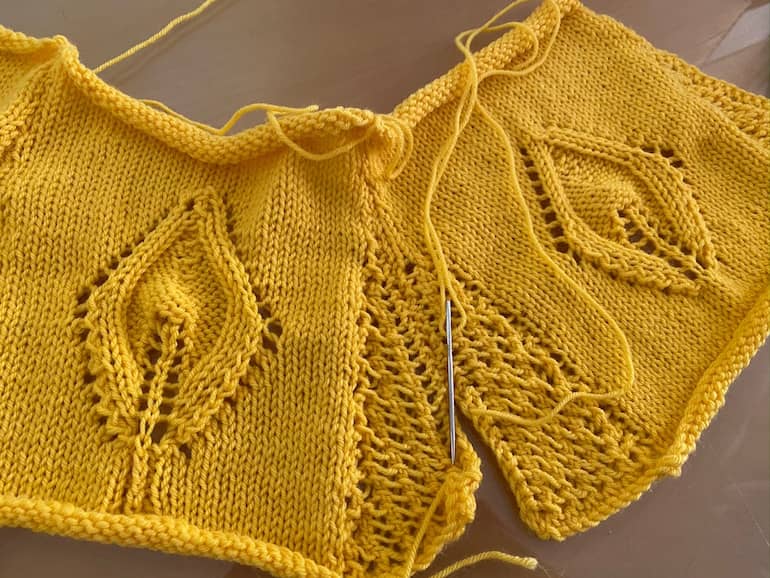
Energy, work in progess, by Eve Jacobs-Carnahan
Art sparks joy
Another purpose of art, in my mind, is to spark joy and laughter. I think that’s the feeling the local newspaper was trying to capture when it described my installation as “a welcoming lantern in an ingenious knitted sweater.”
I tend to resist direct comparisons of my artwork to clothing. The process of making sculptural work is more complicated than constructing a sweater. Here, the eight faces of the lamp formed two trapezoidal prisms, one on top of the other. I encased wire in the top and bottom edges of the upper prism, creating a free-standing structure to slip over the top of the lamppost.
Energy, work in progess, by Eve Jacobs-Carnahan
This was not an option for the lower prism, whose base was narrower than the top. I needed to secure the knitted cover to prevent it from sliding off. If you want to use the clothing analogy, the bottom cover was like pants that needed a belt to hold them up. I lashed that section to the base of the upper prism on site.
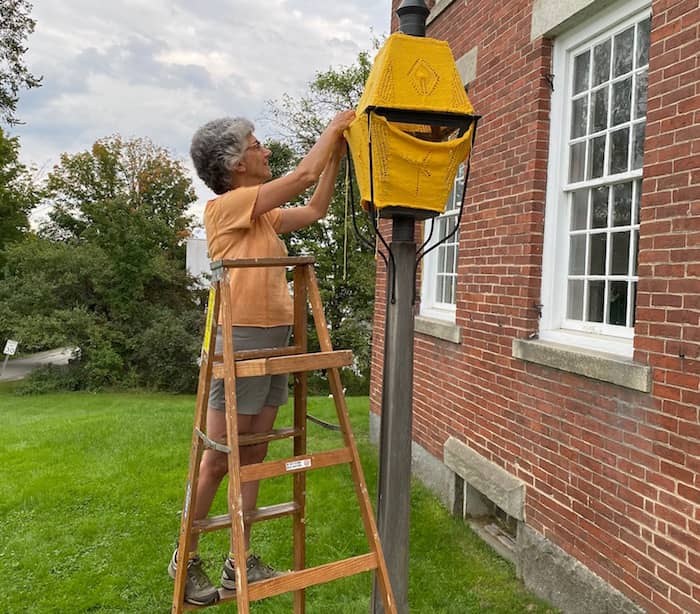
Artist Eve Jacobs-Carnahan installing Energy on lamppost at Kent Museum, Calais, VT, September 2020
Art raises awareness
There’s another purpose of art that’s important to me: to raise awareness of societal issues. The theme of this exhibition was 20/20 Hindsight, emphasizing technological innovation. Street lamps have been lit by candles, gas, and electricity over the years. Their power sources are a microcosm of technological developments.
A new power source we’re harnessing today is wind. People have used the wind to power ships, pumps, and mills for hundreds of years. But using wind to directly produce electricity is relatively recent. In October 1941, the world’s first megawatt-scale wind turbine went online feeding power directly into high voltage lines of a utility system. The Smith-Putnam turbine on Grandpa’s Knob in Castleton, Vermont, was an engineering breakthrough.
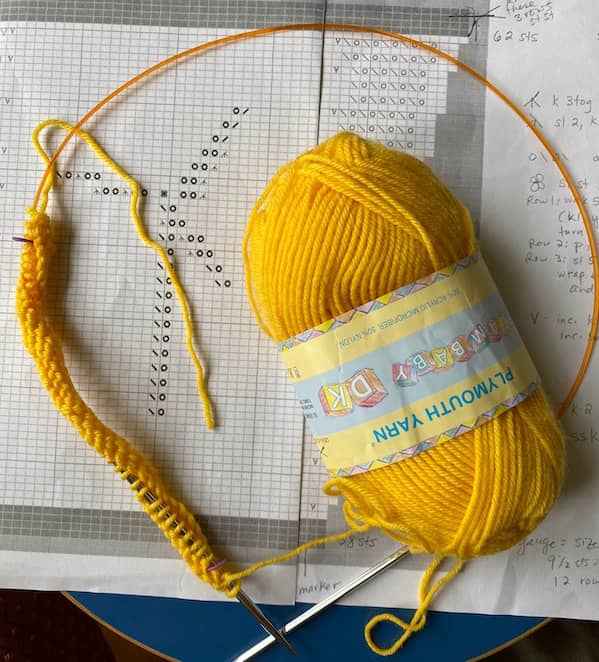
Diagram and initial cast-on row for Energy by Eve Jacobs-Carnahan
By wrapping this lamppost with knitted lace depicting the image of a wind turbine, I highlight an innovative source of energy. We tend to take electricity for granted. I urge you to notice it and think about how we produce it.
See more of my art about issues in society here.

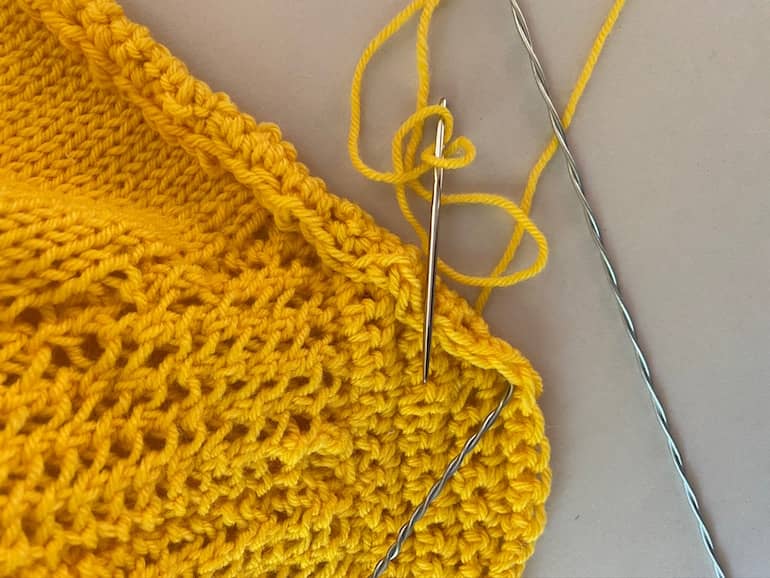
Your photos are great, Eve, but it’s even better in person!
You’re right, Leslie. I’m glad you were able to experience the lamppost Energy in person in that idyllic setting. As the foliage reaches its peak in the next couple weeks, it should look even better.
It is quite a wonderful installation and of course I love the backstory looking at energy in a historical context. I enjoy seeing how the work changes depending on the time of day when it is viewed. Visitors are thrilled by it.
Nel, thank you for inviting me to create the installation! You, Allyson, and David put a huge amount of work and love into Art at the Kent. Your vision consistently creates wonderful exhibitions.
Wonderfully informative post Eve! Thank you.
Thanks,Betsy!